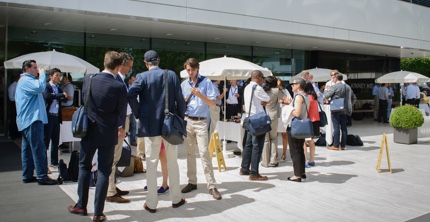
The topic of branding isn’t new, but in an ever-competitive landscape where innovation is getting harder and harder to sustain, how can companies set themselves apart from their rivals?
To really stand apart, said Dominique Turpin, IMD’s Dentsu Chaired Professor of Marketing and Dean of External Relations, companies need to focus on two keywords: ‘meaningful differentiation’.
This, explains Turpin in his session at OWP in Dubai, is a “strategic process to create your company’s story”.
 The company knew, for consumers to see Havaianas as a premium product, traditional marketing communication and advertising wouldn’t be enough.
In response to this, they created emotional an emotional connection with their audience by communicating the backstory of the sandal, which was a basic shoe for poor plantation workers in Brazil.
The company hired leading designers to create attractive, colourful designs and, critically, included the consumer during every step of the design process. Soon international celebrities were wearing the new designs, and this allowed Havaianas to use an “A” class acceptance as an endorsement.
The company also used innovative marketing strategies such as placing a giant model shoe in Sydney and using graffiti artists to market the flip-flop on the side of buildings in New York.
This marketing message suggests innovation and aspiration, said Turpin. It also built on Brazil’s positive image overseas by portraying Havaianas as a colourful, joyful, simple product.
“And they stayed relevant,” said Turpin, “with new annual collections and now more than 300 different styles and colours are on the market.”
“Soon consumers started seeing Havaianas as a premium product. Sales increased and net profit boomed. Now, about 200 million of the flip-flops are sold every year.”
The company knew, for consumers to see Havaianas as a premium product, traditional marketing communication and advertising wouldn’t be enough.
In response to this, they created emotional an emotional connection with their audience by communicating the backstory of the sandal, which was a basic shoe for poor plantation workers in Brazil.
The company hired leading designers to create attractive, colourful designs and, critically, included the consumer during every step of the design process. Soon international celebrities were wearing the new designs, and this allowed Havaianas to use an “A” class acceptance as an endorsement.
The company also used innovative marketing strategies such as placing a giant model shoe in Sydney and using graffiti artists to market the flip-flop on the side of buildings in New York.
This marketing message suggests innovation and aspiration, said Turpin. It also built on Brazil’s positive image overseas by portraying Havaianas as a colourful, joyful, simple product.
“And they stayed relevant,” said Turpin, “with new annual collections and now more than 300 different styles and colours are on the market.”
“Soon consumers started seeing Havaianas as a premium product. Sales increased and net profit boomed. Now, about 200 million of the flip-flops are sold every year.”
Success stories
Pricing is no longer the only thing that matters to customers, Turpin said. A consumer will buy a Nike t-shirt for $100 that has come from the same factory as a t-shirt made for $5 – because they have an emotional connection with the logo. This shows how businesses and investors are increasingly recognising brands as the company’s most valuable asset. Take the success story of Havaianas, for example. “They are, at the end of the day, just rubber flip-flops”, Turpin said. But the Brazilian brand moved into the fashion market and became a premium product. How did it do it? Through meaningful differentiation, said Turpin.
Rethink your marketing strategy through the lens of digital
Become familiar with outside-in and inside-out marketing activities to gain customer insights, and build strong customer connections by exploring the best practices of AI in marketing.
Principles of meaningful differentiation
What can companies learn from this? “Every business needs to establish a clear and meaningful differentiation identity and ask themselves, ‘what is our brand character, what are our brand values, and what is our brand purpose?”, said Turpin. Tech giant Apple, for example, has a brand identity that is “artistic and liberated”, he added. “Their brand values are non-conformist and fun. Their brand purpose is great design and being easy-to-use.” Critically, companies also need to be customer-centric and listen to their consumers – then communicate with them with clear and consistent messaging. They also need to innovate proactively and broadly, said Turpin. “Positioning is all about finding and then focusing on that idea that differentiates your brand from the competition in a meaningful way – this is the foundation for building a stronger, more valuable and sustainable brand,” he said.IMD business school is an independent academic institute with close ties to business and a strong focus on impact. Through our world-leading Executive Education, Master of Business Administration (MBA), Executive MBA, and Solutions for Organizations we help leaders and policy-makers navigate complexity and change. Here at IMD, you can develop your strategic thinking skills by learning alongside senior leaders from around the world – set against the inspiring backdrop of the Swiss Alps.



